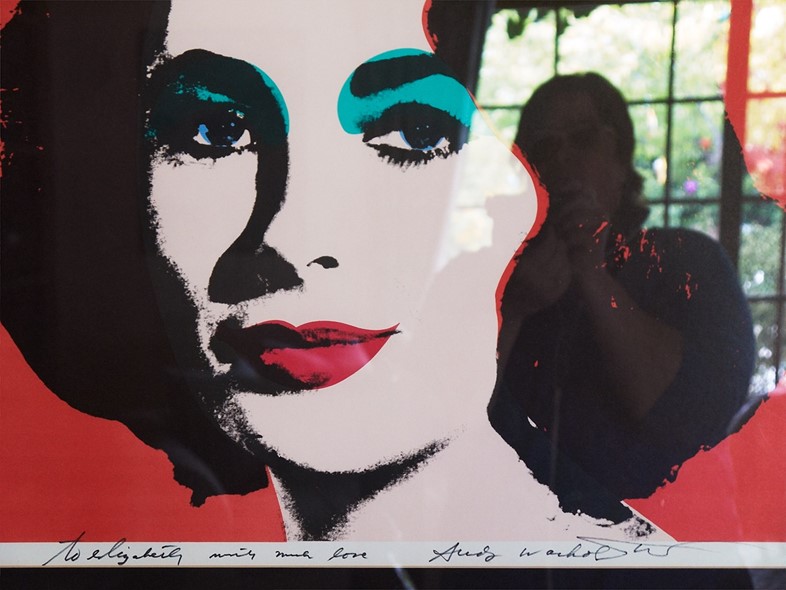In the last months of her life, the Hollywood icon allowed Catherine Opie to photograph her house in LA – and the resulting images, precious and poignant, are now on display in a new exhibit
Though vastly overused, the word icon can still be fairly applied to Elizabeth Taylor. Whether replicated in Andy Warhol's silkscreen inks or the antique grain of a Photoplay cover, hers is one of the most instantly recognisable faces of the last 70 years. Taylor died in 2011, with eight marriages, four children and a vast filmography behind her, but her image in the collective consciousness remains that of the violet-eyed star of Hollywood's golden age.
In the months leading up to her death, however, Taylor agreed to a wholly different portrait. LA-based artist Catherine Opie, renowned for her contemplative, colour-saturated photographs depicting an array of characters and landscapes, from LA's lesbian and gay community, to surfers, football players, mini-malls and freeways, was granted entry into Taylor's Bel-Air home to photograph its interiors. 700 Nimes Road, the title of Opie's current exhibition at the Museum of Contemporary Art in LA, builds a portrait of Taylor through her belongings, from the extraordinary to the banal, and with their owner conspicuously absent – a fact which becomes all the more poignant when we learn that Taylor died part-way through the project.
Opie is currently enjoying a moment: alongside the show at LA MOCA, she is also showing a series of portraits at the Hammer Museum, featuring a roll call of friends and luminaries including Jonathan Franzen, Miranda July and Lawrence Weiner, as well as images from the Taylor project at Lehmann Maupin gallery in New York. Helen Molesworth, the curator of MOCA's new exhibition 700 Nimes Road, takes AnOther on a virtual tour of the exhibition.

On portraiture and voyeurism…
“I think that at heart Catherine has a split practice – portraiture, and landscapes – and to me, this body of work seemed to marry those two methods of approach. It is a portrait, albeit a displaced one, told through objects rather than through a person. But the way the objects are photographed, and the way Cathy is moving through the house, also makes it feel like a landscape. Of course, the interior is highly charged; we all have a somewhat voyeuristic, titillated relationship with being let into this very exclusive private space, and yet somehow Cathy's photos deflate all of that. You might as well as be in your great-aunt's living room. The interior is rendered so spectacularly average, even though there's nothing at all average about it, seeing as most of us don't have framed pictures of Richard Burton and Michael Jackson, or the Krupp diamond. It's an incredible thing, that Cathy's able to do; you get to have all your voyeuristic pleasure without feeling the slightest prick of voyeurism.”

On what we learn about Taylor…
“I think the visitor certainly comes away with a very strong understanding that Elizabeth Taylor was a grandmother, an old woman at the end of her life. Those interiors stop at a certain point; that's the kitchen and that's that. It doesn't matter that the rest of us want stainless steel appliances and black hardware; you come away with the sense of her as a person for whom life was settled, and she was fine.”
On Opie's social realist language…
“Catherine is always extremely mindful of aesthetic and art historic precedent in her work. One thing which comes through that's similar to the work of William Eggleston is this amazing use of colour, as Cathy has captured extraordinary texture and detail. This may be an American thing – I wonder what the interiors Buckingham palace look like? – but in America most celebrities are born working or middle class, and there's a strong undertone of that kind of low-brow American culture in Taylor's home, too. Above the picture of Michael Jackson, for example, there's the most clichéd Venetian tourist gewgaw, a white ceramic mask with feathers. I'm sure that when Taylor was in Venice she was staying in the penthouse of the Bauer, and yet she's buying this tourist tchotchke. That, to me, feels part of what American social realist photographers like Eggleston or Bill Owens hone in on when they're making images of the American interior.”

On her favourite images from the series...
“I love the large format photographs of the clothing in the closets. They're slightly larger than life, and they almost become painterly and baroque in their use of colour and texture. I also love the photograph of the pink drapes in the balloon shape, this voluminous pink silk that is the pink of the body's most tender parts. It sort of looks like boobs or buttocks, and Cathy has really zoomed in on it, and almost abstracted it. There's a great photograph of an oval mirror with a somewhat ornate, gilded frame, too, and in the reflection you can see the handbags in the closet. If I had to steal two photographs out of the show, it would be the handbags and the curtains.”
On Taylor's infamous jewellery collection...
"Catherine racked the focus on those and it's really about the refraction and reflection of light through the diamonds. I think she was very wary of how overdetermined that jewellery is. Again, I don't really know how she was able to escape the tang of voyeurism in the interior, but I think the only way to escape it with the jewellery was to not come at it head-on."

Catherine Opie: 700 Nimes Road runs until May 8 at MOCA.
